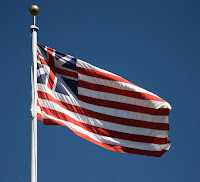He was apprenticed to the sea trade at age 13, a normal starting age for that career. (Young apprentices were expected to continue their schooling on board the ship.) But what wasn't normal was the fact that by age 21 he was captain of the ship. When the original captain and the mate of his ship died of yellow fever, John took charge and brought the ship safely back to port. In reward, the ship's owners confirmed him as captain and gave him part ownership.
His career seemed made for life - until he tangled with an errant crew member who just happened to be from an influential family. The crew member was flogged, a normal punishment for shipboard misdemeanors, but later died... and John had his first clash with trouble.
Conflict would dog him for the rest of his life, but his indomitable spirit would carry him through and into a honored place in history.
From Scottish Merchant to American Naval Captain
After more voyages and more troubles, John felt the need to flee to America, ostensibly to managed the estate of his deceased brother in Virginia. And that was the turning point in his life that pulled him out of obscurity.
 Shortly after coming to America, John Paul added "Jones" to his name (possibly because of his legal troubles back in Britain), and threw in his lot with the embattled American colonies. Joining the brand-new American navy as a First Lieutenant of the USS Alfred in 1775, John Paul Jones raised the first American flag over a naval ship. (If you don't recognize it, it's called the Grand Union Flag and was the precursor to our modern Stars and Stripes.)
Shortly after coming to America, John Paul added "Jones" to his name (possibly because of his legal troubles back in Britain), and threw in his lot with the embattled American colonies. Joining the brand-new American navy as a First Lieutenant of the USS Alfred in 1775, John Paul Jones raised the first American flag over a naval ship. (If you don't recognize it, it's called the Grand Union Flag and was the precursor to our modern Stars and Stripes.)John rose as rapidly in the American navy as he had in Scottish merchant shipping. But the passionate Scotsman could not seem to stay out of trouble, this time picking a feud with Commodore Hopkins. This led to some "stagnation" time in port. But his abilities were too good to dismiss and he made some powerful friends. His rise in the American navy eventually continued.
In fact, Jones caused great consternation to the British by his attacks on both land and sea on the British coast. His successes were definitely a moral boost for the fledgling United States. But it was Jones' mission in 1779 on the USS Bonhomme Richard which was to lead to his lasting fame.
"I intend to go in harm's way"
Now leading a whole squadron of ships, Jones once again headed across the Atlantic and once again had feuds with his men. In spite of this, the little squadron spread fear and dismay through British shipping. This culminated in a meeting of the American squadron and a British merchant fleet in the North Sea. The two British naval ships guarding the convoy closed in to fight, and thus began the Battle of Flamorough Head.
While the squadron engaged one ship, Jones engaged the other, the HMS Serapis. In spite of the bigger guns of the enemy, Jones refused to give up and won the battle against the odds. The enthusiastic, tenacious Scottish American uttered one of the most memorable lines of the war when called upon to surrender:
"I have just begun to fight!"
Jones' Naval Cockade
As an American naval hero, John Paul Jones is often called the Father of the American Navy. However, he shares that title with another gentleman,Commodore John Barry. And it's in a famous letter to Barry that we see Jones' plan for American naval cockades.
Portsmouth, Sept. 7, 1781
The Hon'ble John Barry, Capt.:
Enclosed, dear Barry I have the honor to send you the Cocade I promised, as I forgot to deliver it when I breakfasted with you at Boston. - The Blue in it may, with propriety be adopted as the national Cocade of America, leaving the Black to England which is a true emblem of the character of that Dark minded nation. The white is intended to represent the spotless purity of intention and the sincere Friendship of our illustrious Ally towards these Sovereign independent States - as the Red may represent the glowing Friendship of Spain. - I wish to see this Cocade worn by the Officers of the Navy - at least till a better can be devised - It is known in France as our Cocade of Tripple Alliance, and I have on particular desire presented many of them to the first characters in Europe.
Thus, the first red, white and blue tricolor cockades were actually designed by John Paul Jones!
Final Rest of the Hero
Once American independence was achieved, Jones' later life was enlivened by serving in the Russian navy. However, this came to an end when he began another feud, this time with the Russian government.
Jones was eventually appointed American consul in Algiers but died of kidney failure at the age of 45 before he could take the job.
Buried in a little-known grave in France, his body lay almost forgotten for a century. But in 1905 it was rediscovered and brought back to America,escorted with honor by the US Navy. His body now rests at the Naval Academy Chapel in Annapolis, MD.






No comments:
Post a Comment